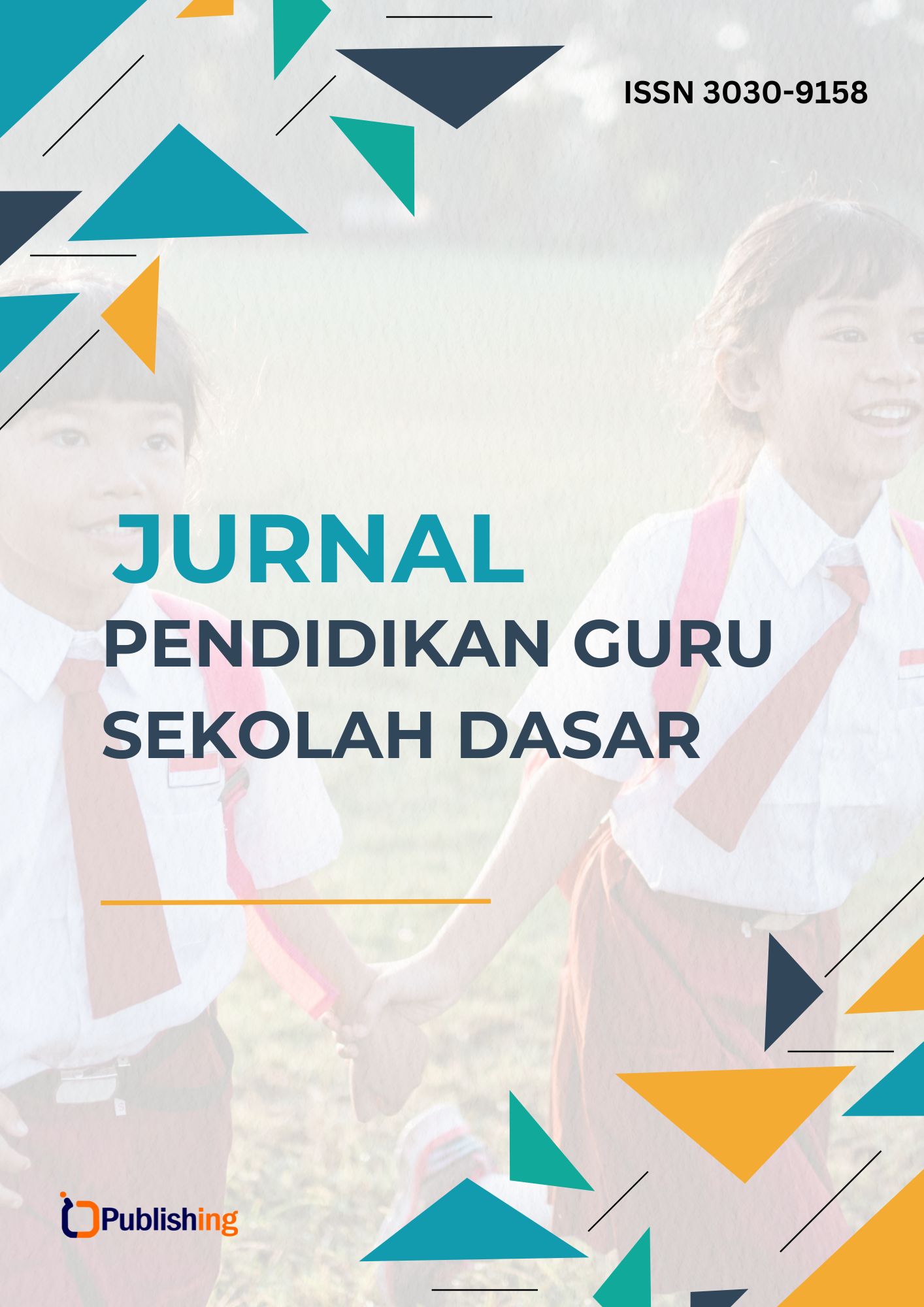Penggunaan Media Pembelajaran dalam Pembelajaran Ilmu Pengetahuan Alam di SD Negeri 104206 Sei Rotan, Kecamatan Percut Sei Tuan, Kabupaten Deli Serdang
DOI:
https://doi.org/10.47134/pgsd.v1i3.359Keywords:
Penggunaan Media, Kreativitas, PembelajaranAbstract
Tujuan dari penelitian ini ialah untuk mengetahui sampai sejauh mana penggunaan media atau alat pembelajaran mata pelajaran IPA di kelas V, SDN 104206 Sei Rotan. Penelitian ini menggunakan metode deskriptif dengan pendekatan kualitatif. Dari hasil data yang diperoleh, diketahui bahwasanya penggunaan media belajar pada mata pelajaran IPA di kelas V SD Negeri 104206 Sei Rotan, Kecamatan Percut Sei Tuan, Kabupaten Deli Serdang. Tergolong cukup. Hal ini tentunya menjadi suatu permasalahan. Sebab, pada kelas tinggi sudah seharusnya bisa mengeksplor pengetahuan alamnya dengan melakukan eksperimen atau mampu mengetahui tata cara penggunaan media pelajaran IPA, seperti kerangka manusia. Kemudian, guru kurang kreatif dalam membuat suatu media belajar sederhana seperti menggunakan bahanbahan limbah. Sehingga guru lebih condong menggunakan buku saja dalam belajar. Pada dasarnya pembelajaran IPA harusnya dapat dinyatakan dalam bentuk konkrit, tidak selamanya bersifat abstrak.
References
Al-Rahmi, A. M. (2022). Integrating the Role of UTAUT and TTF Model to Evaluate Social Media Use for Teaching and Learning in Higher Education. Frontiers in Public Health, 10. https://doi.org/10.3389/fpubh.2022.905968 DOI: https://doi.org/10.3389/fpubh.2022.905968
Alzeer, F. A. (2023). Depression and Quality of Life among Saudi Patients with Vitiligo: A Descriptive Quantitative Review. Open Dermatology Journal, 17. https://doi.org/10.2174/18743722-v17-e230907-2023-5
Ansari, J. A. N. (2020). Exploring the role of social media in collaborative learning the new domain of learning. Smart Learning Environments, 7(1). https://doi.org/10.1186/s40561-020-00118-7 DOI: https://doi.org/10.1186/s40561-020-00118-7
Blanc-Bisson, C. (2022). Motivations of the participants who post a message in an online health forum: a qualitative and quantitative descriptive study in French health forum Doctissimo. BMC Primary Care, 23(1). https://doi.org/10.1186/s12875-022-01906-5 DOI: https://doi.org/10.1186/s12875-022-01906-5
Danjou, P. E. (2020). Distance Teaching of Organic Chemistry Tutorials during the COVID-19 Pandemic: Focus on the Use of Videos and Social Media. Journal of Chemical Education, 97(9), 3168–3171. https://doi.org/10.1021/acs.jchemed.0c00485 DOI: https://doi.org/10.1021/acs.jchemed.0c00485
Dewi, N. R., Yanitama, A., Listiaji, P., Akhlis, I., Hardianti, R. D., Kurniawan, I. O., & Rumah, P. P. (u.d.). Pengembangan Media dan Alat Peraga: Konsep & Aplikasi dalam Pembelajaran IPA. Penerbit Pustaka Rumah Cinta.
Gil-Fernández, R. (2021). Influence of covid on the educational use of social media by students of teaching degrees. Education in the Knowledge Society, 22. https://doi.org/10.14201/eks.23623 DOI: https://doi.org/10.14201/eks.23623
Hani, J. (2019). Social media cyberbullying detection using machine learning. International Journal of Advanced Computer Science and Applications, 10(5), 703–707. https://doi.org/10.14569/ijacsa.2019.0100587 DOI: https://doi.org/10.14569/IJACSA.2019.0100587
Iskandar, S. M., & kawan-kawan. (1977). Pendidikan Ilmu Pengetahuan Alam. Jakarta: Depdikbud, Dirjen Dikti Bagian PPPGSD.
Jamzuri, M. P. (u.d.). Hakikat Alat Peraga.
Khan, T. M. (2021). Use of social media and WhatsApp to conduct teaching activities during the COVID-19 lockdown in Pakistan. International Journal of Pharmacy Practice, 29(1), 90. https://doi.org/10.1111/ijpp.12659 DOI: https://doi.org/10.1111/ijpp.12659
Khan, W. (2022). Stock market prediction using machine learning classifiers and social media, news. Journal of Ambient Intelligence and Humanized Computing, 13(7), 3433–3456. https://doi.org/10.1007/s12652-020-01839-w DOI: https://doi.org/10.1007/s12652-020-01839-w
Lyu, M. (2019). Learning-based lensless imaging through optically thick scattering media. Advanced Photonics, 1(3). https://doi.org/10.1117/1.AP.1.3.036002 DOI: https://doi.org/10.1117/1.AP.1.3.036002
Majid, A. (2007). Perencanaan Pembelajaran. Bandung: Penerbit Rosda Karya.
McWhirter, A. (2024). Learning, Teaching, and Social Media: A Generational Approach. Learning, Teaching, and Social Media: A Generational Approach, 1–217. https://doi.org/10.4324/9781315204116 DOI: https://doi.org/10.4324/9781315204116-1
Niu, W. (2022). Impact of Perceived Supportive Learning Environment on Mathematical Achievement: The Mediating Roles of Autonomous Self-Regulation and Creative Thinking. Frontiers in Psychology, 12. https://doi.org/10.3389/fpsyg.2021.781594 DOI: https://doi.org/10.3389/fpsyg.2021.781594
Noori, A. Q. (2022). The use of social media in EFL learning and teaching in higher education of Afghanistan. Cogent Social Sciences, 8(1). https://doi.org/10.1080/23311886.2022.2027613 DOI: https://doi.org/10.1080/23311886.2022.2027613
Nurhidayah, I. (2020). Quality of life of family caregivers of children with leukemia: A descriptive quantitative study. Belitung Nursing Journal, 6(2), 52–58. https://doi.org/10.33546/BNJ.1041 DOI: https://doi.org/10.33546/bnj.1041
Reinhardt, J. (2019). Social media in second and foreign language teaching and learning: Blogs, wikis, and social networking. Language Teaching, 52(1), 1–39. https://doi.org/10.1017/S0261444818000356 DOI: https://doi.org/10.1017/S0261444818000356
Reinhardt, J. (2020). Metaphors for social media-enhanced foreign language teaching and learning. Foreign Language Annals, 53(2), 234–242. https://doi.org/10.1111/flan.12462 DOI: https://doi.org/10.1111/flan.12462
Safapour, E. (2019). A review of nontraditional teaching methods: Flipped classroom, gamification, case study, self-learning, and social media. Education Sciences, 9(4). https://doi.org/10.3390/educsci9040273 DOI: https://doi.org/10.3390/educsci9040273
Susanti, S., Dewi, P. I., Saputra, N., Dewi, A. K., Wulandari, F., Tasdin Tahrim, & Sholeh, M. (2022). Desain Media Pembelajaran SD/MI. Yayasan Penerbit Muhammad Zaini.
Vizcaya-Moreno, M. F. (2020). Social media used and teaching methods preferred by generation z students in the nursing clinical learning environment: A cross-sectional research study. International Journal of Environmental Research and Public Health, 17(21), 1–10. https://doi.org/10.3390/ijerph17218267 DOI: https://doi.org/10.3390/ijerph17218267
Wang, J. (2022). Multi-Metabolomics Coupled with Quantitative Descriptive Analysis Revealed Key Alterations in Phytochemical Composition and Sensory Qualities of Decaffeinated Green and Black Tea from the Same Fresh Leaves. Foods, 11(20). https://doi.org/10.3390/foods11203269 DOI: https://doi.org/10.3390/foods11203269
Wiyono, B. B. (2021). The Use of Technology-Based Communication Media in the Teaching-Learning Interaction of Educational Study Programs in the Pandemic of Covid 19. ICEIEC 2021 - Proceedings of 2021 IEEE 11th International Conference on Electronics Information and Emergency Communication, 103–107. https://doi.org/10.1109/ICEIEC51955.2021.9463846 DOI: https://doi.org/10.1109/ICEIEC51955.2021.9463846
Zeng, X. (2019). Quantitative Descriptive Analysis of Sensory Quality of Citrus grandis. Guangdong Agricultural Sciences, 46(6), 23–29. https://doi.org/10.16768/j.issn.1004-874X.2019.06.004
Downloads
Published
How to Cite
Issue
Section
License
Copyright (c) 2024 Christopel Silitonga, Rani Rosaria Tinambunan

This work is licensed under a Creative Commons Attribution 4.0 International License.










